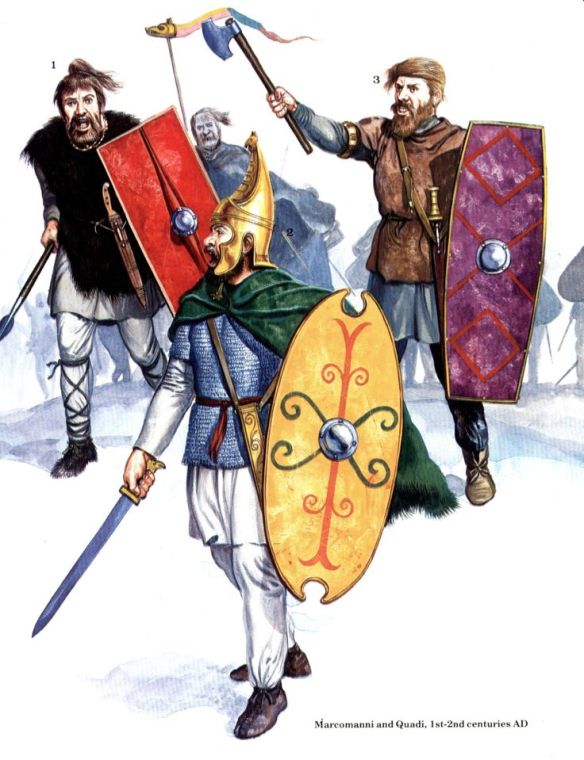The Marcomanni and Quadi, 1st-2nd centuries A.D. These figures represent the most politically advanced and cohesive group of Germanic tribes of the 1st and 2nd centuries A.D. They lived in close contact with the Roman Empire and were, in consequence, exposed to strong Mediterranean influences. The chieftain, 2, wears a bronze helmet which appears in reasonable detail on the sculpted sarcophagus of a late Antonine general now in the Museo Nazionale delle Terme, Rome. We show it here as a Roman cavalry battle helmet mounted with a fabulous beast head to suit barbarian taste; it may, in fact, have been a cavalry sports helmet of a pattern normally equipped with a trilobate face mask, which has been removed. His mail corselet is of iron, and may have been of native manufacture; the possibility of continuing manufacture of weaponry by Celtic craftsmen in the barbaricum is a distinct and attractive one. The oval shield has an indent top and bottom; this pattern, and a dilobate type, seem to be peculiar to these Suebian Germans, but they also used the more common hexagonal and round patterns. The sword is of Roman origin, and has an eagle-headed pommel-there was a considerable trade in Empire-made weapons across the frontiers. The upper-class warrior, 3, wears two woollen tunics, and the usual long trousers. The short sleeves of the outer tunic may have been ‘notched’ part way up from the hem, centrally: this feature is seen in sculptures on the sarcophagus of a Roman general who fought these tribes on the middle Danube. The hair is arranged in the ‘Suebian knot’, drawn over to the right temple. His weapons are a native sword on a leather baldric, and a battleaxe. Both 2 and 3 would have fought either mounted or on foot, as circumstances dictated. 1 is an ordinary Suebian tribal warrior, dressed in rough woollen material with a warm jerkin of fur or fleece. He carries a javelin, a sax, and a shield of an old pattern, and wears amber and meerschaum beads in a double row at the neck. The cross-gartering on the legs cannot be absolutely dated to this earl y period; but several well-preserved corpses dating from the Celtic and Roman Iron Ages, recovered from northern European bogs, appear to wear this style-e.g. the Rendswührer Fen find of 1871. The fur shoes are taken from a find in Fraeer Fen, Jutland-they were made of two thicknesses, the fur on the inside of the inner layer and the outside of the outer layer. In the background is a draco standard, a hollow bronze beast head with an attached ‘windsock’ of coloured fabric.
By the middle of the 2nd century, pressure on Rome’s northern frontier was mounting as the numerical increase among German tribes impelled their leaders to look for new ground. Goths and other German tribesmen began to move south-east in a steady stream. This movement blossomed into the Gothic nation of southern Russia and the Gepid nation of the Carpathians; the Astingi (Asding) Vandals moved into territory west of the Roman province of Dacia, formerly dominated by the Sarmatian Iazyges. The Roman military command must have followed these developments with foreboding. To the north-west, the Rhine tribes were entering into the super-tribe status of permanent federation. As early as the 1st century A.D. pressure was building on the middle Danube frontier; Roman strongholds had existed with Dacian agreement in the area since the first conquest of Dacia in 106 A.D., on the left banks of the rivers Danube, March and Thaya. During the winter of 166-7, the Lombards, a west German group, crossed the frozen Rhine, carrying with them the Lacringi, Victofali and Ubii. They were immediately followed by a breakthrough of Marcomanni, Quadi and Sarmatian lazyges in the central Danube area. From then on a kind of ‘blitzkrieg’, launched by a barbarian conspiracy, sucked in ever-increasing numbers of barbarians, in spite of a Roman offensive in 170, directed against the Quadi in particular. Roman armies were by-passed on the left and right flanks, and Greece was invaded. Early in 171 Italy too was subjected to brief invasion, which was quickly nullified by Roman forces rushed from the frontier areas. Later in the year Marcus Aurelius rid the Empire of invaders, and peace was negotiated with the Quadi and Iazyges. In 172 the Marcomanni were attacked by Roman forces on the Danube. The Quadi, breaking their treaty with Rome, assisted their Suebian kinsmen. After defeating the Marcomanni, Marcus turned to the Quadi, who were attacked and defeated in 173. The Quadi then made peace. In 174, Roman troops attacked the Iazyges, whereupon the Quadi broke their treaty once more. The war continued into 175, until an armistice was declared in the summer of that year.
During these vicious wars, serious weaknesses in the defences of the north were exposed. The Empire had been invaded and devastated. The constant fighting had made extremely heavy demands on the army at all levels, and, at one point, the gladiatorial schools were emptied in a desperate experiment. The struggle with Rome during the Marcomannic wars had brought far-reaching changes to the Germanic peoples, and created in them an eagerness to launch more assaults on the colossus in the south. Sixteen of Rome’s 33 legions manned the northern frontier, together with large numbers of auxiliary troops, at the end of the Marcomannic wars-an end which proved to be only a beginning for the Germans.
The tribes most closely involved in these wars the Marcomanni and Quadi, were Germans belonging to the Suebian group of tribes. These Germans had become relatively civilized after a long period of contact with Noricum and Pannonia. Their close knowledge of the operational system and eager acquisition of the technology of the Roman army made these tribes formidable opponents.
